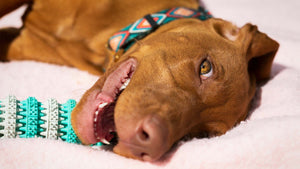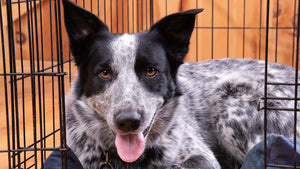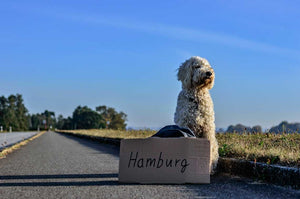Your Cart is Empty
💗FREE shipping on Oprah's Favorite Dog Walking Bag! Everything ships FREE on orders over $30 💗
💗FREE shipping on Oprah's Favorite Dog Walking Bag! Everything ships FREE on orders over $30 💗
💗FREE shipping on Oprah's Favorite Dog Walking Bag! Everything ships FREE on orders over $30 💗
💗FREE shipping on Oprah's Favorite Dog Walking Bag! Everything ships FREE on orders over $30 💗
Add description, images, menus and links to your mega menu
A column with no settings can be used as a spacer
Link to your collections, sales and even external links
Add up to five columns
Add description, images, menus and links to your mega menu
A column with no settings can be used as a spacer
Link to your collections, sales and even external links
Add up to five columns
March 31, 2022 9 min read
We love our dogs, but their hair always manages to float into even the most hidden spots of the house! Different breeds shed their fur differently throughout the year, so it’s important that dog parents know what to expect and know how to handle shedding. A good dog brush or pet hair remover helps control shedding, eliminate stray hairs, and keeps you living in harmony with your four legged family member.
If your dog seems to shed a lot of hair, don’t worry; dog shedding is normal, especially in spring and fall, as your pup changes their coat for the upcoming season. Shedding removes damaged or dead fur from the body and makes room for new hair to grow. How much a dog sheds depends on a few things, including genetics, diet, time of year, and health. Is your dog shedding so much that there’s cause for alarm? Let's shed some light on this topic - pun intended!
Genetics
Some dog breeds grow a short-haired coat, while others have long hair. Pups with long hair on their body tend to have a thick undercoat to keep them warm, which leads to lots of shedding, especially as new coats grow in. Pups with shorter hair often shed less, making less of a mess for their parents.
Dogs with long-haired coats that tend to shed a lot include:
Diet
A diet rich in proteins, healthy fats, vitamins, and minerals will help your pup maintain a healthy and lush coat. If a pup is not properly nourished, a poor diet can result in a dry flaky coat and excessive scratching, which, in turn, causes increased hair loss.
Season
As weather gets warmer again, dog have to shed their heavier coats so that it's easier to cope with the heat. Dogs with long hair and a thick undercoat tend to shed more during this time. However, some breeds like the Akita and Alaskan Malamute shed more heavily throughout the year. Weather-dependent shedding is different for every breed.
Health
Psychological conditions like stress can increase shedding in dogs. In a scientific study that aimed to uncover the correlation between cortisol and hair loss in dogs, scientists discovered that stress and underlying diseases can trigger hair loss in dogs. Glucocorticoid levels in dog hair generally increase with age, but these stress hormones also increase when a dog goes through physical, emotional, or psychological trauma.
Medical conditions that trigger excess hair loss in dogs
If your dog has sudden severe, unexplainable shedding, this can be a warning sign that something is wrong. Intense shedding is often a symptom of an underlying medical condition that needs immediate diagnosis and treatment. Diseases that can cause extreme hair loss in dogs include:
Shedding season is one of the most dreaded times of year for many dog parents--understandably so! Some breeds can leave the carpet totally covered with hair. This often means contending with pet hair all over your furniture, upholstery, and car seats. Fortunately, there are ways to minimize pet hair and maintain a habitable, comfortable environment for you and your pet.
Look out for underlying conditions
If your dog is exhibiting unusually excessive shedding and showing other signs that something may be wrong, it's time for a vet visit to rule out whether the shedding is due to parasites, viruses, bacteria, or allergies (food or environmental). Detecting and treating skin conditions like mange and impetigo can help control excessive shedding and, more importantly, prevent worsening of other uncomfortable and unpleasant symptoms.
Weekly baths
Bathing your dog once or twice a week helps to remove loose hair and dander. For dog parents with heavy-shedding pups, you may have to increase the weekly baths during intense shedding seasons like spring and summer. Invest in a clean label dog-friendly shampoo that does not have any harmful chemicals that will dry and irritate your dog's skin; this can lead to excess shedding. Good news coming soon -- keep an eye out for Puppington's upcoming launch of our own gentle, moisturizing, anti-itch shampoos that are perfect for dogs of all breeds and ages!
Deshedding shampoo can be a helpful tool, as it removes stubborn tangles, dirt, and debris from your dog's coat. This kind of shampoo also has active ingredients for strengthening hair strands and minimizing breakage. Most quality deshedding shampoos on the market use natural ingredients like calendula and papaya extracts. These shampoos may also contain Omega 3 and Omega 6 fatty acids to nourish the skin and coat of dogs.
Brush your dog’s coat
Regular brushing will reduce stray dog hair in your home. Most dogs love the feeling of being brushed, so you might not have to work too hard to get your pup to agree to this one. It’s a win-win for you both!
Pick up a deshedding brush
Ensure that you invest in a quality dog brush that suits your dog's specific size and coat type. Puppington's double-sided brush for shedding dogs is a great multipurpose option. In addition, consider all-natural pet hair removal tools, like grooming stones, that provide a sustainable way to remove pet hair and dander. You can use a grooming stone to clean furniture, carpets, and other surfaces at home and in your car too!
Keep your pup hydrated
Ensuring your dog gets enough clean drinking water will help keep their skin hydrated and healthy.
Feed your pup a healthy diet
If your furry friend has a dry, itchy, or dull-looking coat, it could be a sign that they are missing essential vitamins and minerals for their skin and coat. Opt for nutrients that enrich your dog's skin like Vitamin E, Zinc, Copper, and B Vitamins. A natural diet will help your dog get many of these essential nutrients. You can also enrich your dog's diet with clean label, healthy, veterinarian formulated supplements like Pup Snax™ to make sure your dog gets all the essentials for skin and coat health.
Minimize stress
Stress and anxiety in dogs are one of the causes of excessive shedding. Dogs do not do well with stress, and these increased cortisol levels often lead to physical symptoms such as excessive shedding. To help, reduce stressors around your home and find ways to help your dog stay calm and collected. Exercising your dog regularly will also help stabilize their moods and keep them healthy.
Brushing your pup is one of the best ways to help control shedding, and it’s very good for your dog’s coat. Plus, as an added bonus, most pups love the feeling of being brushed! Brushing your pup’s coat can provide you with the opportunity for quality bonding time.
It’s important to choose a pet hair remover that suits your dog's specific coat type. As discussed earlier, dogs are either short-haired or long-haired with coarse or smooth strands. Very short-haired dogs have one layer of fur, while dogs with long hair have a top coat and a thick undercoat.
Buying a perfectly sized dog brush allows you to reach into the strands without irritating your dog’s skin. There are four dog hair remover options on the market:
Deshedding dog brush
Deshedding tool
Grooming stone
Deshedding shampoo
Deshedding dog brush for shedding dogs
Dog brushes come in all different shapes and sizes. A pet comb meant for a long-haired coat will likely not be as effective when used on a short hair coat. Universal pet hair remover brushes do exist, but brushes designed for your dog’s hair type and shedding amount are ideal.
Some of the other dog hair removal brushes on the market are:
Slicker brushes
Slicker brushes have short, fine metal bristles clustered on a flat surface. This pet-grooming tool is ideal for dogs that have a medium to long coat with curly strands. The slicker brush combs through the curly hair, removing tangles and dead matted hair. Most slicker brushes have a flexible handle for ease of grooming. Make sure to be gentle when using a slicker brush because it can cause discomfort when you apply too much pressure. Also, use this brush sparingly on a long-haired dog to avoid matting. Slicker brushes are ideal for Golden Retrievers, St. Bernard Dogs, Yorkshire Terriers, and Cocker Spaniels.
Rake brushes
Rake brushes resemble a gardening rake and are great for brushing dogs with thick coats. They have two rows of tightly clustered pins that comb through thick strands to remove tangles and dead hair. Rake brushes suit dogs with dense undercoats like the Malamute and German Shepherd. The fine pins will reach into the undercoat and remove stubborn matted hair. This type of brush also comes in handy when you want to get rid of debris hiding deep in the coat.
Bristle brushes
Bristle brushes are the best for smooth, short coats that shed frequently. The bristles are soft and closely packed. This ergonomic design helps by removing loose hairs and massaging the skin in the process. If you own a Pug, Italian Greyhound, Boston Terrier, or a Jack Russell Terrier, a bristle brush is a great tool for keeping their coat clean and shiny. If you just gave your dog a brush, it's also a great brush for all dogs for distributing oils to give that final shine.
Pin brushes
Pin brushes have an oval shape with flexible bristles that have pins on top. The comb bristles are scattered to allow the comb to hit the fur at different angles, allowing them to detangle hair. Pin brushes are ideal for combing out loose hair before it reaches your bed, furniture, or car seat. This type of brush is the most common of the brushes we mention, and it is best for general brushing.
Flea combs
A flea comb is an affordable and versatile dog brush. Flea combs have fine bristles arranged in a straight line. As you comb through your dog's fur, fleas get trapped between the bristles and removed from your dog's coat. A flea brush is an essential item in every dog grooming kit--you never know what your pup might come home with after a romp outdoors!
Deshedding comb/tool
A specialized deshedding pet hair remover is a dedicated tool that sometimes has multiple rows of teeth of different lengths. Deshedding tools have stainless steel bristles often with an ergonomic handle for comfort. When used correctly, a deshedding comb will reduce excess undercoat fur and keep your dog's skin and coat healthy.
Use a deshedding comb after bathing and drying your dog. Check for any cuts, bruises, inflammations, sores, or skin conditions on your dog's coat, as you don’t want to further irritate such sensitive areas. It’s helpful to start with a slicker brush to remove tangles and dead hair before going in with the deshedding dog comb.
After removing dead hair, gently brush with the deshedding tool in the direction the fur grows. Ensure the steel bristles are angled at an edge while brushing. Brush from the head towards the tail. Also, apply gentler pressure while brushing sensitive areas like the legs, tail, and around genital areas.
Avoid overbrushing and always comb through the fur gently and away from the skin to prevent injuries.
Grooming stone
A grooming stone is often made from lava stone or pumice with a very coarse porous surface. Grooming stones remove dirt and dried debris on a dog's coat. They are ideal for dogs with short to medium-length hair.
Use a grooming stone to remove parasites like botfly larvae from your dog's coat. A pet hair removal stone can also help with the removal of dog hair that is stuck on furniture, carpets, and clothes. A grooming stone is a very sustainable, reusable pet hair removal tool that is lightweight and durable.
Benefits of eco-friendly dog brushes
Here at Puppington, we believe that switching to eco-friendly pet products is a really great way to do your part for the planet. You can start the process by buying dog brushes made with renewable materials like sustainable wood.
Wooden dog brushes are very comfortable to hold. The wood handle is natural, very ergonomic, and more moisture-resistant compared to hardwoods.
Choose the Best Dog Brush for Shedding Dogs and Manage Your Dog's Shedding
We hope we've shed some light on why your pup may be shedding so much and how you, as a dog parent, can minimize pet hair around your home. Understanding your dog's coat type and ensuring there are no other underlying reasons for shedding are the first steps. Then, find a good dog brush that suits your pup's coat type. Puppington's 2-in-1 Deshedding Brush is a very versatile, double-sided option that works with short and long-haired coats. Include pet hair remover accessories like deshedding combs and deshedding shampoo in your dog's grooming kit. Also, feed your dog a healthy diet and keep them well hydrated to minimize pet hair and dander in your home. Doing all these things will help make sure that you and your pup are comfortable at home!



Comments will be approved before showing up.